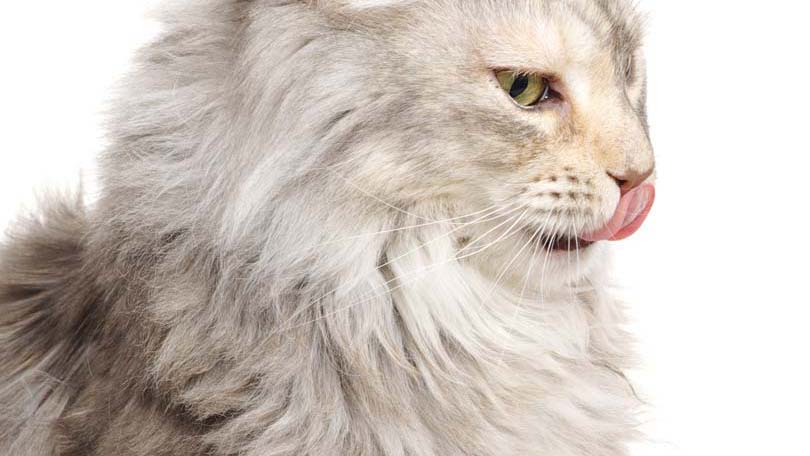
We all know the signs. A gag, a cough, a few retches. You walk into the room to check on your cat, and there he is walking away quite proudly from that stinky, steaming, hairy mass on the carpet. The cats job might be done, but yours has just begun.
Cleaning up hairballs is the unfortunate, but all too common task that falls to cat-owners. Once a week or so, you’ll hear that sound, and your heart will fall. Time to dig out the paper towels, and go to work.
In order to eradicate the evidence of hairballs on your carpet, care must be taken when cleaning them up.
The first step to cleaning up hairballs is to actually get rid of the hairball. All evidence to the contrary, it’s not alive, and the longer it sits there, the more of the accumulated fluids and digesta within it will soak into the carpet, and even to the pad below. Take care where you dispose of the offending item- unless it’s trash day, leaving it in a kitchen trash can may not be the best course of action. Smaller hairballs may be flushed down the toilet, or utilize an outdoor dumpster, or even better, your neighbors garbage can.
Instead of scrubbing the area immediately, spray or pour a good amount of carpet cleaner, stain cleaner, Lysol, or whatever your preferred spot removal substance is, onto the affected area of carpet, and let it soak for 5-10 minutes. This will help to break down the odor causing fluids and bacteria within the carpet.
Finally, scrub the carpet vigorously with a damp terrycloth and water. The use of vinegar on the stain can help to eliminate any lasting odors, but make sure that the vinegar will not affect or stain your carpet before using it.
The best way to clean up hairballs is to prevent them from existing in the first place. This is best done through prevention, in the form of grooming your cat for him. Because cat tongues are covered with a comb-like papillae that catches dead hair and unable to spit it out, the cat swallows that hair. Hair is not digestible, and instead stays in the stomach or intestines, slowly accumulating more hair as well as food material. When this hair bolus becomes big enough to be irritating to the stomach, or begins to interfere with eating and drinking, the cat will cough, hack and retch and in most cases, vomit up the offending hairball.
By brushing your cat daily, you can help to minimize, if not prevent completely the hair that they ingest by grooming. If grooming is not an option, shaving down a long-haired cat can be quite effective in reducing the amount of hair he is able to ingest. Your cat may not thank you right away for that lion cut, but over time his health will be better for it.
Traditional hairball remedies, available at your local pet store, can help to encourage hairballs to pass in the feces. Usually made of a gel, they are administered for several days to help lubricate and add bulk to a hairball to assist it passing through the intestines.
For cats with recurrent hairball problems, commercial diets are available that help to consistently allow hair in the stomach to pass in the feces, preventing a build up. In addition, adding a small amount of canned, unflavored pumpkin to your cats diet can help add bulk to his food, also encouraging hair to pass in the feces.
Cleaning up hairballs may be disgusting part of cat ownership, but in general it is quite easy to get rid of the associated stain and smell from them. Unfortunately, the same cannot be said of eradicating cat urine from your carpet.
Cat urine, especially that of un-neutered male cats, has the dubious distinction of being one of the worst and hardest to eliminate smells in the universe. The distinctive smell will permeate any and all substances it comes into contact with, and even some of the strongest cleaners and disinfectants will fail miserably when it comes to getting rid of cat urine.
Thankfully, specially made enzymatic cleaners that attack cat urine specifically have been created, and these have quickly become a must-have for every cat owner. Designed to digest the organic material of urine and other bodily fluids, enzymatic cleaners actually eat away at the urine and destroy the odor-causing bacteria within it, neutralizing the odor.
While there are many types of enzymatic cleaners, it is imperative to use a product designed specifically for cat urine. This will both ensure that the product will be effective on cat urine, but also ensure that the product is non-toxic to cats. Febreze, a common enzymatic cleaner found in most supermarkets, can be toxic and even fatal to pets. Your local pet store should be able to recommend an appropriate product for your task.
When cleaning up cat pee accidents, the majority of the urine still needs to be soaked up with a paper towel- take care not to get any on your hand, or you really won’t be able to get away from that smell! Pour a very liberal amount of cleaner onto and around the pee spot. Let that sit for at least 15 minutes, and then clean vigorously. After, apply your enzymatic cleaner. As urine will generally soak through the carpet into the pad below, you must use a then pour a good amount of cleaner on and around the urine spot, so that it will soak into the same areas the urine did originally. As an added bonus to their use, enzymatic cleaners do not need to be soaked back up after use- instead, the longer the area stays damp, the better, as the cleaner continues to digest and destroy odor causing bacteria in the urine.
Cleaning up hairballs and other cat accidents can be an annoying but ever present fact of life. If these accidents occur frequently, it may be a good idea to look into buying a steam carpet cleaner, to efficiently and thoroughly clean large areas of carpet. Be sure to use a pet specific detergent in the carpet cleaner, to ensure all your work is put to good use. Then, sit back and enjoy your clean carpet… and try not to be too disappointed when you hear that sound again.





